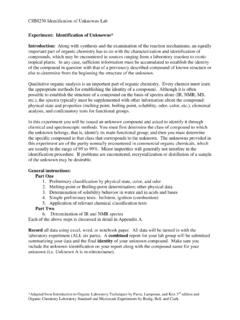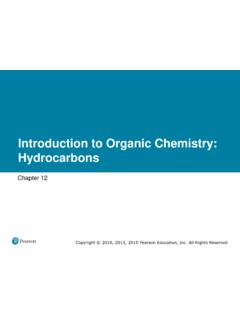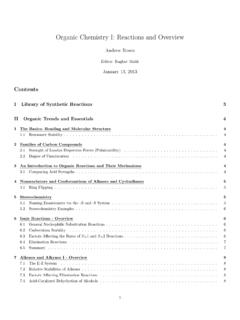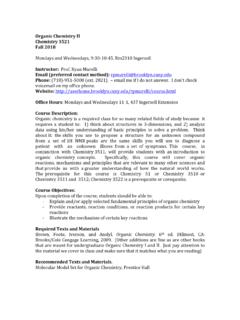Transcription of organic lecture 1 - University of Texas at Austin
1 lecture 24: organic chemistry An introduction I am not the best person to be giving a lecture on organic chemistry the world is filled with two kinds of people, the ones who despise organic , and the ones who love it. During the year I took organic in college, I was also plastering the words from sad songs all over my dorm room walls looking back I realize there was a cause and effect relationship between organic and typing up those songs. Honestly, I always thought the lunch each Tuesday afternoon before my organic lab felt pretty much like a person going before a firing squad, only it happened over and over and over for an entire year. With that off my chest, here is a nice lecture that surveys the important foundational concepts for the vocabulary that describes organic chemistry .
2 Mostly you will get a feel for the fact that organic is a lot of nomenclature and a lot of systematic rules. For those who likes languages and lists, and for those who can close their eyes and imagine a three-dimensional world of molecular structures, organic is quite easy. For those, like me, who would rather reduce the subject to a couple of simple mathematical formulas, it is quite difficult. I mean, what kind of science course doesn t need a calculator. But enough rant. Things you already know about organic just because you took my course. As much as I don t like organic , the physical basis for pretty much everything you would learn in organic is developed in freshman chemistry some things you need to remember throughout your organic course are: Bonding theory like VSEPR, VB and MO that allow you to draw the structures, even in three dimensions.
3 Your friend, EN, which allows you to assign local and molecular polarities of the electron clouds and armed with where + and - assignments across an organic compound, let you intelligently discuss physical properties and chemical reactivities with the best of them. After all, you have worked a huge number of organic chemistry problems throughout the year. For example: Tell me everything you know about the compound CH3CH2OH (ethanol): To start, you are actually capable of drawing this 3-dimensional image of ethanol yourself using simple bonding ideas. The large grey balls are the carbon, the small grey balls are the hydrogen and the red ball is oxygen.
4 So what can you already say about this molecule from being a student in general chemistry ? Plenty. All the atoms achieve a Nobel gas structure, either 1s2 for H or 2s22p6 for the C and O. The C and O have four electron rich regions which means they have tetrahedral electronic geometry, are approximately bond angles, and have sp3 hydridization. The carbons have four bonding regions and are either tetrahedral or distorted tetrahedral molecular geometries, AB4. The oxygen has two non-bonding electron pairs and is AB2U2, or angular, electronic geometry. There are only sigma bonds in the molecule in other words, all the bonds lie between the atoms.
5 Specifically there are 8 sigma bonds,5 formed from sp3-1s overlap in C-H bonds, one formed from sp3-sp3 overlap in the C-C bond, one formed from the sp3-sp3 overlap in a C-O bond and one formed from the sp3-1s overlap in an O-H bond. If we were to assign electronegativities (H = , O = and C = ) we would find that all eight bonds are polar covalent ( EN < ). If we tried to sum all the EN in the molecule, we would find that the CH3 (methyl) region is fairly non-polar (small total EN in the region), but the region around the oxygen is fairly polar, as is the overall molecule, because of the big electronegativity of oxygen relative to H.
6 This polar molecule also happens to possess both instantaneous dipoles associated with the hydrocarbons, but more importantly, hydrogen bonding because of the H attached to an electronegative atom, O. This means that ethanol is going to have very strong intermolecular forces. Having very strong electronegative forces means that ethanol has a low vapor pressure, a high viscosity, a large capillary action, and high melting and boiling points among other physical properties related to a large IMF. Having hydrogen bonds means that ethanol will be miscible in water, which is good because it means liquor can be diluted. It is also immiscible in most non-polar materials.
7 Those carbon-hydrogen bonds love to react with O2 and halogen gases for that matter, and a nice combustion reaction, with CO2 and H2O as products can be drawn. Among other things we know that this combustion reaction will be spontaneous, exothermic, increase the entropy of the surroundings and do work on the surroundings. Oh, and of course, there is an activation barrier to this combustion reaction which is why we have to toss a match on the ethanol for the combustion reaction to happen (with a large pre-exponential factor in an Ozarka bottle and a small A value on a surface like my hand.) And that O in the 3-dimensional picture is red for a reason.
8 It screams: I have all the electron density. This means this is where the action is in a chemical reaction. And for those of you who take organic , you would do well to draw a - near the oxygen and remember that is where the + in other molecules is likely to go if given the chance in a reaction. Well I could go on and on and on with other stuff we have learned and can apply to ethanol. But I will stop and reemphasize two important points: You aren t really going to be taught any new chemistry next year in organic Instead, you will spend the year doing what I have done above for ethanol, for a million other compounds.
9 So all I really need to do now is to teach you some nomenclature and you can just go ahead and test out of organic by saying, yeah, yeah, Laude already taught us all that bonding, reactivity, thermo and kinetics stuff. organic chemistry Nomenclature. Why does it take a year to do organic the study of a single atom, carbon? The reason is that pesky carbon atom is remarkably adept at forming different kinds of molecules. For example, if I were to draw all the legal ways to put together 12 C atoms and 26 H atoms (to satisfy the Nobel gas configuration) there are 355 correct structures, each with its own unique properties. And then if we let the C react with all the compounds that form covalent bonds, like N, O, Cl, P, S, etc.
10 , the possibilities explode exponentially. And organic chemists want you to be able to draw and name everyone of those compounds and then explain why one of them evaporates just a little faster, or reacts just a little slower, than another. So I guess they can have their year. But it is still just stuff you learned in my class. Alkanes: The basic organic compound is an alkane it has only C and H bonds, and every one of those bonds is a sigma bond. Alkanes are not very exciting because they don t do much reacting. But they are a great place to start learning nomenclature. To begin, every organic molecule has three parts defined by a VERY systematic set of rules: a prefix a parent a suffix The parent is the length of the longest carbon chain like methane for one carbon, ethane for two carbons, heptane for seven carbons The prefix contains any substituents on the molecule besides the parent C chain like an extra methyl or hydroxyl group The suffix is the family in which the compound falls based upon the functional group attached to the parent chain for example, the suffix ol indicates that ethanol is an alcohol.










